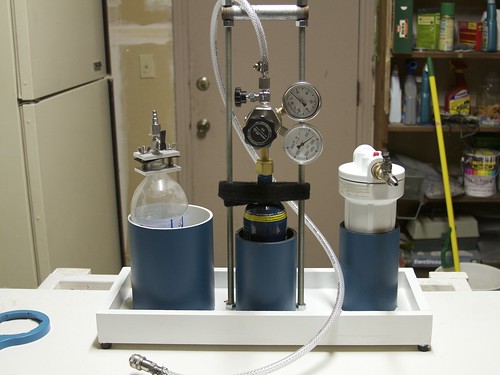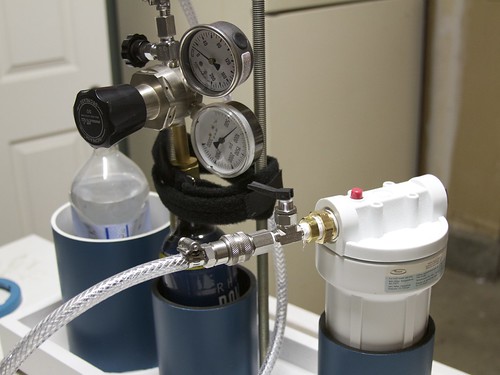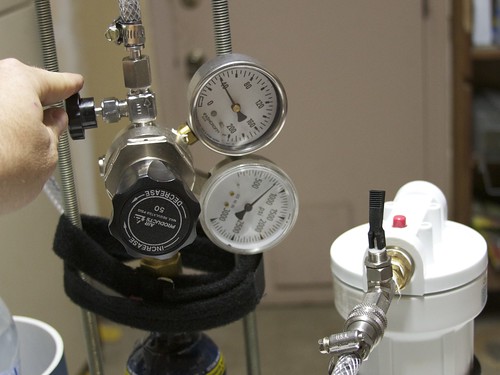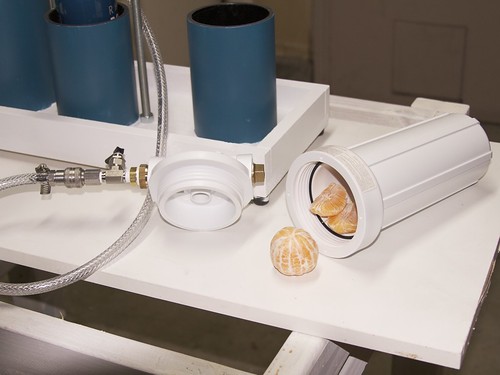A guest project by Rich Faulhaber, contributing Evil Mad Scientist.
“Infusing unsuspecting whole fruit with gaseous CO2 in the entire Tri-State Area!”
In an effort to make fruit fun for the kids, I built a carbon dioxide injector from parts in my garage with the purpose of carbonating whole fruit! With a common house water filter housing, a 16 Oz paintball CO2 canister, an old gas regulator, and some miscellaneous valves and fittings, I was able to bring this fizz fruit apparatus to life, and the kids love the results.
The principle
Carbon dioxide dissolves well in water, hence the reason you find it as the source of fizz in all your favorite soda drinks. When you open your soda and let it sit out on the counter you will find that after some period of time the soda loses its fizz and becomes “flat.” The rate at which the drink loses its fizz depends on pressure, temperature and the surface area of the liquid and the environment. Skipping the thermodynamics lecture, let me just tell you that the process works in reverse as well. To reverse this process, one needs only to have a high pressure CO2 environment, a medium to infuse (i.e., the fruit) and enough time to let the gas diffuse across the fruit skin and dissolve into the water inside. Refrigerating the fruit helps tremendously in the process as well.
Parts list
- 16 Oz paintball cylinder (or a more proper CO2 tank if you happen to have one)
- Gas Regulator
- Household water filter housing
- Some hose
- Toggle or ball valve
- Miscellaneous fittings to hook it all up
- Fruit
This type of water filter housing is designed to withstand water pressures in excess of 100 psi, and it comes with two ports and an o-ring seal. These can be bought for about ten dollars at Lowes or Home Depot. Its ports are standard 3/4-inch type. Use Teflon tape (plumbers tape) on all the threads. Thread in a plug on one side and a valve on the other. I used a toggle valve with a quick disconnect to make everything easier. The hose can by any standard type rated for at least 100 psi. Small bundles are available in the plumbing section of your hardware store.
For gas handling I used an old single stage regulator. These can be quite expensive new but often times you can find deals at garage sales or in surplus stores. You don’t need anything fancy, just something to step down the pressure to something manageable– well below 100 psi. My CO2 source is a standard-issue paintball cylinder.
Procedure:
- Pre-chill the fruit in the refrigerator. Get it nice and cold. My favorites are grapes, oranges and blueberries. However, just about any fruit with a large water content will work.
- Open the house water filter by unscrewing the lid. Place your cold fruit inside.
- Connect the CO2 tank to your water filter housing. This is where the quick disconnects come in handy.
- Adjust the regulator output to about 40-60 psi, the higher the better but make sure all your connections are extra tight and sealed or “it might get dangerous.” If you think you have a leak somewhere, you can apply some soapy water where you think the leak is and look for bubbles. If you see bubble just tighten until they stop forming.
- Start pressurizing the house filter by opening the toggle valve. On top of the water filter housing there is a pressure relief button. Depress this while you fill to get some of the residual air out.
- Once pressurized, shut the toggle valve and disconnect the CO2 line. You can store the unit in the fridge or somewhere out of sight.
- Then, you wait. Depending on the fruit, temperature, and pressure, carbonation should occur between 20-60 minutes. If you go too long at too high a pressure the skin of the fruit can burst and it will be a big mess, if you go too short and at too low of a pressure, the results will be unimpressive. Experiment with your fruit, pressure, and duration until it suits your tastes.
- Open the toggle valve to release the pressurized gas then unscrew the lid to the housing and enjoy your newly carbonated fruit.
And of course, the kids love the “poppy fizz” inside the fizzy fruit.








This is fantastic. Love it.
Just a quick tip, however…the CO2 canisters for paintball guns / welders can contain oil and all manner of gunk. Better to get hold of CO2 designed for soda fountains / syphons just in case.
Exciting!
Figuring out something just like this has been on my procrastination list since this summer when we accidentally carbonated some grapes in a cooler full of dry ice.
Any container can contain oil and gunk. As a rule, I have not found paintball co2 cylinders to be one of those that do. Smaller co2 cartridges (8g, 12g, 16g) that are not specifically food grade probably do. The mouth size of those containers do not permit them to be washed and cleansed of manufacturing lubricants easily. I have found 20oz cylinders and larger tanks (up to 50lb tanks) to be clean on purchase.
You can buy (fairly cheaply) in-line filters that remove such gunk from gas supply lines. They clog fairly easily so need to be replaced if you need high flow rates.
Also, regarding the N2 vs. CO2 posts below… it has to be CO2 to get the acidity (carbonic acid). Other gases will make bubbles, but it will not taste sour/tart/acidic when the bubbles pop on your tongue.
How would you go about doing a medium or large melon?
Mellons?
Gallagher!!
I have heard of people carbonating watermelon, but I am not sure there is an inexpensive vessel that can contain both a watermelon and 80psi safely. The best way would be to buy or borrow a commercial sized pressure pot – even better if it has an axillary inlet. If it does not, you can unscrew the pressure gauge and fit a valve there. Do not override or repurpose the blowoff/safety valve as your pressure inlet. I’d think that you’d need to at least quarter the melon first but maybe not??
You can probably cut up melon into slices and use a soda keg (cornelius-stlye keg) to carbonate the slices. The price for a pressure-tested keg varies from $35 (used) up to $130 (new) so inexpensive is relative. However the hardware for attaching these to a CO2 tank is available from any homebrew supply store since they’re widely used in home brewing.
A bit expensive but in the long run it has to be cheaper than Fizzy Fruit [link:]bit.ly/ijsdPq
Like the Fizz Giz, this thing can probably carbonate a soda in about 20-seconds flat. There’s an excellent video at http://www.fizzgiz.com, at http://www.sodamaker.biz and on youtube at http://www.youtube.com/watch?v=lRgfsa8zOio
The water filter’s bigger mouth allows for larger pieces of fruit than PET soda bottles. I would suggest putting ice cubes in with your fruit to help keep it cold. The colder, the better when it comes to carbonation.
Ice is not needed. Just close the valves, remove the hose, and put in your fridge.
What, no monologue about how you didn’t have carbonated fruit when you were a child? :) Dooby dooby doo-bah…
With the weather warming up, I can’t wait to build one of these for all the fruit we take to the pool.
Thanks for the great article!
–Ed
How quickly does the fruit go flat again? Is there a way to transport them, short of keeping them in the pressurized water filter? It might be nice to pack one in your lunch for work in the morning, but carrying around plumping might be awkward. :)
The amount of time the fruit stays carbonated is deetermined by many factors, like what type of fruit temperature of the fruit how much carbonation has occurred etc. You will just have to experiment. I will say this green grapes which have a much thicker skin than red grapes work better for this setup and can hold carbonation for hours. Red grapes were "ok" but were much more fragile and tended to burst at anything above 40 psi. Most of the time however the kids and I eat the fruit faster than they lose carbonation.
I’m also curious about the length of time the fruit will hold a "fizz". I’m sure there are a number of factors that would influence the time; i.e., type of fruit, temperature, etc. Can anyone who has tried this offer an approximate time frame or window for how long before the fruit fizzles out.
Is the fitting(s) between the Paintball tank and the regulator anything special? Can such an item be found at a hardware store lowes/home depot/sears?
IIRC the CO2 tank has a center pin that has to be depressed.
Also lowes has regulators and the water filter for for ~$20 each.
Hello, sorry I failed to mention. You are indeed right you have to depress the pin in the cylinder with an adapter. The adapter is fixed to my regulator so I forgot. I think you can pick them up at any homebrewing store for arround $5.
OK. Any -inator is cool to begin with but this definitely looks like something I many need to try :) .
Nice Doof reference. Hopefully small animals won’t show up to ruin my carbonated fruit fun after building this device.
I was wondering if you could use an air compressor to supply the pressure for the chamber. Some little chunk of memory says that the paintball tank refill stations were just high pressure compressors. Is there something special about CO2 that normal air would not dissolve into the water?
Air is mostly Nitrogen which doesnt disolve nearly as well in water as CO2. I am not 100% sure but I think a beer like guiness has a different gas or some mixture of gasses to give the foam a creamy texture. Perhaps home brewers can offer suggestions on other gases to use, nitrous oxide maybe?
They use nitrogen introduced at the tap. In the bottles, there is a plastic container of nitrogen that pops when the cap is removed. The N2 gives a finer bubble resulting in the distinctive head and waterfall action of the head rising.
That is not exactly correct. The plastic bubble in the Guinness can is full of Guinness and gas. The nitrogen is added to the can (In liquid form) so eliminate O2 and add pressure. When you pop the pop, pressure in the can drops, and the bear in the bubble is forced out a small whole. This is what creates the foam.
As someone who has been around a homebrewing brother (and a new homebrewer myself), i never thought about using forced carbonation this way. Definitely going to try it.
JayZeis
abeerinhand.blogspot.com
I love it for the Phineas and Ferb reference alone! The resulting fizzy fruit is an added bonus.
I never thought about carbonating fruit before and this set up is pretty slick. The issue of oil in the cylinders is correct. Any type of compressed gas cylinder not used for food/beverage/medical use can contain oil if used in an industrial type of setting, and is toxic so just becareful. As far as the carbonation methods, for stouts like Guiness the blend of gas is actually 40% Co2 and 60% Nitrogen. You need the Co2 to create the carbonation in something. It is the reaction of Co2 with water or other fluids that creates carbonation. The one post that use of Nitrogen creating finer bubbles and head is correct, but it’s also to mitigate the temperature of the beer itself. For stout, it’s blended Co2/Nitrogen is done in the gasous phase, where as straight Co2 is used in beer and soda is not only for carbonation but also cools the liquid as it’s blended and is mixed as liquid Co2. Sorry for the science lesson, just thought you might like to know why this works.
But…but…but…it’s a pollutant and evil! What would you have us put evil into our food? Shame on you. I’m calling the EPA!
But… but… but it’s a regular part of air, and necessary for plant life. We’re all doomed! May as well have some fizzy fruit in the meantime…
I am looking for something fun for kids at a science fair and this would be perfect! My only worry is that it would take too long to carbonate "while you wait". How long would it take to carbonate a peeled mandarin at 6 bar (90 psi)? We could always increase the pressure….
Just have two filter housings and pressurize 1 beforehand.
Don’t run at higher pressures, for safety’s sake.
Here’s an experiment to try: Get the fruit REALLY cold (say, 40F) and pressurize it for just a few minutes. See how carbonated that gets.
I’d suggest at least mentioning that there is some implied dangers in building this device. The biggest one is that the water filter may be able to withstand a 100 PSI static pressure, but it is designed for 100 PSI of water pressure which is nearly incompressible. 100 PSI of gas pressure will have a significantly higher energy and would act like an explosion if something were to damage it. The filter certainly isn’t designed for gas use at those pressures.
Yes, it’s important to keep the pressure low, and to make sure that the pressure vessel is not damaged, warped, cracked, etc.
$10 replacement is less than a trip to the emergency room. Don’t take any chances.
Unless your fortunate enough to live in a country with public healthcare!
Even the best medical care can’t help you if you get some shrapnel in your brain.
The plastic shrapnel in my brain has no bearing on my ability to coherent a complete shiny, nor penguin. Oooh pretty!
So i built one of these based on the plans provided. I can say one thing for sure… if you make it the way this guy suggests it will not work! Sealing the actual canister is the hardest part, you will need extra gaskets and even then the seals on the filter will not hold any pressure in excess of 40 psi.If any of you have ever made a potato launcher use those plans and principles and expand from there. Schedule 80 pvc is rated for higher pressure and shouldn’t compromise under the pressure needed to actually force carbonate the fruit. Beyond that when you do get it to work the resulting flavor is not that great. Blackberries…. think blackberry coke that has no sugar in it. The best thing to do is make a simple syrup ( equal parts water and sugar heated to emulsify, then chill for use), soak the fruit in that overnight in the fridge and then carbonate. After carbonation store in the fridge to maintain low temp and then enjoy!
> if you make it the way this guy suggests it will not work!
It sounds like you had a defective filter, or simply didn’t know how to operate it. Concluding that "it will not work!" from that is quite a stretch.
Obviously filters like that *always* have to be sealed against pressure to work correctly. If you were installing it as a filter, it sounds like you would probably come to the conclusion that "filters never work!"
Windell H. Oskay
drwho(at)evilmadscientist.com
http://www.evilmadscientist.com/
Simpler, food grade option:
Use the regulator as only an adjustable pressure relief valve, or use a regular pressure relief valve. Put the fruit at the bottom, and the pressure relief at the top (so it will release air, not CO2). Protect the fruit with a washed tuna can, then add dry ice on top of the can, close the lid, and wait.
You will get the cold that will help, everything will be food grade (no oil), and if you can find the right pressure, the relief valve should be available cheap (less than $15). It does require you to purchase dry ice, which does not store as well, but other than that, it should work very well. Just be sure that your relief valve lets go at a lower pressure than your vessel is rated at.
Success!
Yesterday morning I became determined to have a working dry-ice setup by night so I could share it with friends. The first version was made before I understood what a pressure regulator did (I thought it was a relief valve), so v1.0 just… didn’t work.
After a quick second trip to the hardware store, I was able to scrounge up a pressure gauge and a ball valve. This version, while dangerous, did get some appreciable results. :)
Since I couldn’t find any local stores that sell relief valves, I ordered one through amazon (100psi). For better or worse, it should mitigate the feeling of being a mad scientist who has to go run around a corner before performing a very loud emergency venting. :P
As for keeping the dry ice separate from the fruit, the simplest effective solution I found was to put some crushed dry ice and a little bit of hot water at the bottom of the vessel, a small inverted drinking glass for separation, and then the fruit on top of that. Also, a nice way to contain a fruit salad was literally just an open ziplock bag (it initially seals around the edges, but the CO2 of course pushes its way up around the sides of the bag).
Oh, and some kiwi and strawberry slices turned out quite nicely! (but grapes definitely took the show)
You Sir, are a Double Bacon Genius Burger.
Well done.
Can I do this with pasta?
I’ve been wanting to make Bubblicelli for a long time.
I’m working on something similar except its more cost efficient and instead of CO2 I am using dry ice. Dry ice is very cheap where I live (about .5 a pound) and I can easily regulate it with a pressure gauge and a ball valve.
This has got to be the coolest thing ever, I know my kids would absolutely love this. I notice when you were talking about the parts to make this you mentioned some type of water filter. Could you also use a refrigerator water filter?